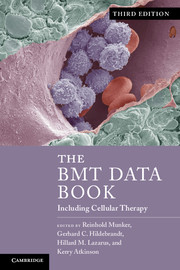Book contents
- Frontmatter
- Contents
- List of contributors
- Foreword
- Preface
- Acknowledgments
- Section 1 Basic science
- Section 2 Hematologic malignancies
- Section 3 Solid tumors
- Section 4 Nonmalignant disorders
- 15 Therapeutic decision making in BMT/SCT for severe aplastic anemia
- 16 Therapeutic decision making in BMT/SCT for congenital immunodeficiencies
- 17 Therapeutic decision making in BMT/SCT for hemoglobinopathies
- 18 HSCT for inborn errors of metabolism and neurodegenerative disorders
- 19 Therapeutic decision making in BMT/SCT for autoimmune disorders
- Section 5 Cellular therapy
- Section 6 Practical aspects and procedures
- Section 7 Complications
- Section 8 The BMT/SCT pharmacopoeia
- Section 9 HLA-testing and laboratory medicine
- Appendix Guide to the internet and literature databases relevant for BMT/SCT
- Index
- References
19 - Therapeutic decision making in BMT/SCT for autoimmune disorders
Published online by Cambridge University Press: 05 August 2013
- Frontmatter
- Contents
- List of contributors
- Foreword
- Preface
- Acknowledgments
- Section 1 Basic science
- Section 2 Hematologic malignancies
- Section 3 Solid tumors
- Section 4 Nonmalignant disorders
- 15 Therapeutic decision making in BMT/SCT for severe aplastic anemia
- 16 Therapeutic decision making in BMT/SCT for congenital immunodeficiencies
- 17 Therapeutic decision making in BMT/SCT for hemoglobinopathies
- 18 HSCT for inborn errors of metabolism and neurodegenerative disorders
- 19 Therapeutic decision making in BMT/SCT for autoimmune disorders
- Section 5 Cellular therapy
- Section 6 Practical aspects and procedures
- Section 7 Complications
- Section 8 The BMT/SCT pharmacopoeia
- Section 9 HLA-testing and laboratory medicine
- Appendix Guide to the internet and literature databases relevant for BMT/SCT
- Index
- References
Summary
Introduction
Severe autoimmune disorders often have a chronic relapsing course characterized by flare-ups, remissions, further progression, and finally incapacitation. Autoimmune disorders may target many different organ systems. Multiple sclerosis is characterized by inflammation and an autoimmune attack on myelin fibers, resulting in demyelination and later axonal loss. Rheumatoid arthritis is characterized by an autoimmune attack against the synovial membrane, resulting in chronic inflammation and joint destruction. In severe cases, autoimmune disorders may cause death from multiorgan involvement. A common principle for the treatment of most autoimmune disorders is immunosuppression. The evidence for the value of high-dose chemotherapy with stem cell support comes from three lines of evidence: (a) it was speculated that higher dose immunosuppression or immunoablation could eliminate the pathogenic autoreactive cells more thoroughly; (b) in a number of case reports, patients who underwent a BMT/SCT for a hematologic malignancy and had a coincidental autoimmune disorder came into remission of both diseases (Drachman & Brodsky, 2005); and (c) it could be demonstrated in animal experiments that the transfer of syngeneic stem cells following immunoablation may cure several autoimmune disorders (Sykes & Nikolic, 2005).) In the European data base, 900 patients underwent an auto-SCT between 1996 and 2007 for a variety of autoimmune conditions (Farge et al., 2010). In this chapter I will review the treatment results for multiple sclerosis, rheumatoid arthritis, and systemic lupus erythematosus (SLE), as well as discuss future developments.
- Type
- Chapter
- Information
- The BMT Data BookIncluding Cellular Therapy, pp. 205 - 208Publisher: Cambridge University PressPrint publication year: 2013



